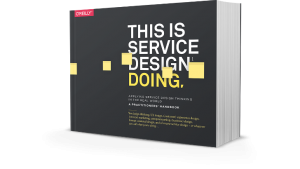
The book is a follow up from This is Service Design Thinking (Stickdorn and Schnieder) and delivers a practical framework for those looking to implement Service Design in their organisations. The new book does not replace the old one, nor is the earlier a prerequisite. While there is some overlap, that section is framed as an update based on the years of experience the authors have had in between the two tomes.
TISDD Service Design Framework
The focus of the book is to provide a framework for “doing” service design. Much of the content will be familiar to academics, business analysts and other practices as it borrows from across different disciplines. The book is divided into several sections.
The first section creates the framework. Why should organisations embrace service design, what it is and what are the basic tools and core activities of service design. It culminates in presenting the TISDD service design framework.
Four chapters then detail the four core activities and details the methods in each that make up process of service design. These are research, ideation, prototyping and implementation. Each chapter provides information around the different tools organisations can use to complete the process. The book is also supported by an on line library of 54 method descriptions that go into more detail. The next chapter describes the process that these activities can fit into.
For example the research chapter covers different methods of collecting qualitative and quantitative information. There are tips and techniques but the book is not a detailed guide to delivering each of the methods. It provides a description of them, a high level overview of what they do and how they can assist with the overall process. Some readers will be familiar with many of the methods, but the reader is rarely bored and it flows through the description quickly. At the end of each chapter is a series of case studies from different guest authors about their use of some of these methods, what they achieved and some pitfalls.
Odd man out or inspired example?
There is one section of the book that feels slightly out of place although this does not mean that it is not a valuable addition. In the implementation chapter there is a section by Minka Frackenpohl that compares the stages of architectural design to service design. The section delivers a useful compare and contrast to the two processes. In due course it might form part of a larger chapter that looks at best practices within different industries.
The final section contains practical advice around how to set up a service design practice in an organisation. It covers workshops, the environment that service design works best in and the final chapter gives some tips on how to embed service design into organisations. Again, each is supported with case studies from the independent contributors.
Summary
One of the features of service design thinking, according to the authors, is that all contributors are acknowledged. The editors have done this by including short biographies of the different contributors. This is a nice touch, they have also included a huge number of references as footnotes. This means that as you read the book you are able to quickly reference secondary information if you wish to side track yourself. The only issue with these is in the font size used, it is small.
Early in the book the authors look to explain service design in different ways:
- As a mindset
- As a process
- As a toolset
- As a cross disciplinary language
- As a management approach
All of these are relevant and the only one that probably isn’t addressed in depth is the first, Service Design as a mindset. This may be have been covered in the first book. It would have been useful to include a section to explain this further. One might argue that the book as a whole aims to do this. However, for those just looking to understand what service design is, it is a small omission in what is a comprehensive book. For anyone looking to implement service design in their organisation it is well worth a read. The website that supports the book also promotes the editors training and consultancy services.
Buy at Amazon.co.uk
Buy at Amazon.com


























“Odd man out or inspired example?”
Hi Steve,
Thanks for the positive review!
The section you mention is one of four in that chapter which look at the implementation contexts of service design with reference to Change Management, Software, Product Management and (the one you mention) Architecture.
All the best,
Adam Lawrence
Co-Editor, #TiSDD
[…] that idea before ideation and certainly before rushing into building a prototype. It has echoes of service design, one of the disciplines that Sholay has drawn from to develop Oracle […]